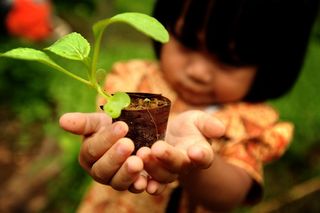
Natural Medicine is Great, but Chemists Can Make It Even Better (Op-Ed)

This article was originally published at The Conversation. The publication contributed the article to Live Science's Expert Voices: Op-Ed & Insights.
For years humans have searched for medicines in nature. While some seek “natural cures” in order to avoid chemicals, in truth everything is made up of chemistry. But as humans, we’re very good at manipulating what we find in nature – either through intention or accident.
Penicillin: the antibiotic game changer
The late American anthropologist George Armelagos showed 30 years ago that the inhabitants of ancient Nubia made their beer by fermenting grain that contained streptomyces bacteria, which produces the antibiotic tetracycline. This in turn led to very low levels of infectious disease in the population.
But it wasn’t until the accidental discovery of penicillin by Alexander Fleming in 1928 and work done by Howard Florey and Ernst Chain in 1940 that led to the treatment of many wounded soldiers in World War II that the story of modern antibiotics really began.
There are many different molecules in the penicillin family – for example, Penicillin G, the substance made by Florey and Chain, contains 41 atoms. But all of them have the same core made up of two rings of atoms – mainly carbon atoms – fused together. Different molecules have different properties. One drawback of penicillin G was that it was broken up by stomach acid and could only be administered by injection.
But penicillin is manufactured by fermentation, and chemists found that they could produce penicillins with slightly different structures by changing the chemicals added to the fermenting broth. Different structures allowed researchers to produce penicillin, for example, that was stable to acid and allowed it to be taken by mouth.
It also subsequently became possible to mass-produce 6-aminopenicillanic acid – the molecule at the heart of the penicillin structure – and to then add side-chains of extra atoms to design a particular penicillin, like one that could tolerate threatening bacteria enzymes. This process is known as semi-synthesis – using the molecular structure from a natural source before adding “finishing touches”.
Sign up for the Live Science daily newsletter now
Get the world’s most fascinating discoveries delivered straight to your inbox.
After the discovery of penicillin, there was intense interest in finding new antibiotics. The discovery of a molecule called chlorotetracycline (Aureomycin) in a sample of Missouri soil in 1945 led to a whole family of tetracycline antibiotics. These now semi-synthetic products include doxycycline, effective against Lyme disease and anthrax.
Invermectin: the golf course find
The 1970s yielding another important discovery from a microorganism named Streptomyces avermectinius, found in a soil sample from a seaside golf course by Japanese scientists. From this they isolated a molecule called avermectin, which proved active against numerous parasites. Still not satisfied, researchers made small tweaks to its structure to make it even more active. By dint of adding just two hydrogen atoms (to a carbon-carbon double bond) they created ivermectin.
Ivermectin is a tremendous success story in the treatment of river blindness (onchocerciasis), a scourge of communities in tropical regions in the Americas and sub-Saharan Africa. This disease is due to a parasitic worm Onchocerca volvulus and is spread by certain black flies. A single dose of ivermectin every six months for the life cycle of the worms can keep the parasite at bay.
Artemisinin: standing the test of time (just)
An even greater scourge of sub-Saharan Africa is malaria, and the great discovery in the past half-century has been artemisinin, obtained from the Chinese herb Artemisia annua. Artemisinin itself is not easily absorbed by the body so chemists have slightly altered its molecular structure and created new molecules – this is semi-synthesis at work again.
These have very similar structures to artemisinin but are more effective agents called arteether or artesunate. The latter of these can be administered intravenously for rapid action so is used against acute cerebral malaria where the disease spreads rapidly to the brain and can be fatal within three days.
But chemists can’t be complacent – the genes of the malaria parasite have shown an ability to adapt to become resistant to artemisinin. And as one of the most effective remaining antimalarial drugs, resistance is a serious problem.
Aspirin: the daddy of semi-synthetic
And the daddy of all semi-synthetic drugs is aspirin. Back in the 18th century, an Oxfordshire clergyman named Edward Stone pioneered the use of willow bark in treating fevers; the bark contained a molecule called salicin, which in the body is transformed into the active compound, salicylic acid.
By the 1870s, salicylic acid itself was being used to treat fevers and pain, but digestive problems and ulcers were associated with its use. So chemists working for the German company Bayer converted it to acetylsalicylic acid, known today as aspirin, and that rapidly became the medicine of choice as an anti-inflammatory and painkiller.
Nature is the best synthetic chemist there is. It creates unbelievable molecules – both penicillin and artemisinin contain groupings of atoms that chemists thought could not exist – but they show that chemists can still improve on nature’s bounty and make amazing molecules that work even better in treating human ailments.
Simon Cotton does not work for, consult to, own shares in or receive funding from any company or organisation that would benefit from this article, and has no relevant affiliations.
This article was originally published on The Conversation. Read the original article. Follow all of the Expert Voices issues and debates — and become part of the discussion — on Facebook, Twitter and Google +. The views expressed are those of the author and do not necessarily reflect the views of the publisher. This version of the article was originally published on Live Science.
